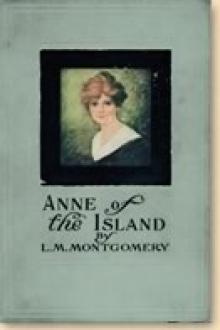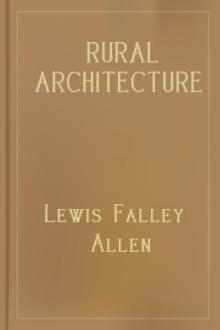A History of Art for Beginners and Students, Clara Erskine Clement Waters [best beach reads .txt] 📗

- Author: Clara Erskine Clement Waters
- Performer: -
Book online «A History of Art for Beginners and Students, Clara Erskine Clement Waters [best beach reads .txt] 📗». Author Clara Erskine Clement Waters
About 1813 or 1814 Turner purchased a place at Twickenham; he rebuilt the house, and called it Solus Lodge. The rooms were small, and contained models of rigged ships which he used in his marine views; in his jungle-like garden he grew aquatic plants which he often copied in foregrounds. He kept a boat for fishing and marine sketching; also a gig and an old cropped-eared horse, with which he made sketching excursions. He made at this time the acquaintance of Rev. Mr. Trimmer, the rector of the church at Heston, who was a lover of art, and often took journeys with Turner. While visiting at the rectory Turner regularly attended church in proper form; and finally he wrote a note to Mr. Trimmer, alluding to his affection for one of the rector’s kinswomen, and suggesting: “If Miss —— would but waive bashfulness, or in other words make an offer instead of expecting one, the same [Lodge] might change occupiers.” But Turner was doomed to disappointment, and never made another attempt at matrimony. In 1814 Turner commenced his contributions of drawings to illustrate “Cook’s Southern Coast,” and continued this congenial work for twelve years, making forty drawings at the rate of about twenty guineas each; the drawings were returned to the artist after being engraved. In 1815 he exhibited the “Dido Building Carthage,” and in 1817 a companion picture, the “Decline of the Carthaginian Empire,” and for these two pictures the artist refused five thousand pounds, having secretly willed them to the National Gallery.
Ruskin divides Turner’s art life into three periods: that of study, from 1800 to 1820; that of working out art theories toward an ideal, from 1820 to 1835; and that of recording his own impressions of nature, from 1835 to 1845, preceded by a period of development, and followed by a period of decline, from 1845 to 1850. Besides his pictures painted on private commission, Turner exhibited two hundred and seventy-five pictures at the Academy. The “Rivers of England” was published in 1824, with sixteen engravings after Turner; another series contained six illustrations of the “Ports of England”—second-class cities. In 1826 the “Provincial Antiquities of Scotland” was published, with thirteen illustrations by Turner. The same year he sold his house at Twickenham, because, he said, “Dad” was always working in the garden, and catching abominable colds. In 1827 Turner commenced the “England and Wales” on his own account, and continued it for eleven years. It consisted of a hundred plates, illustrating ports, castles, abbeys, cathedrals, palaces, coast views, and lakes. In 1828 Turner went to Rome by way of Nismes, Avignon, Marseilles, Nice, and Genoa; and this year painted his “Ulysses Dividing Polyphemus,” of which Thornbury says: “For color, for life and shade, for composition, this seems to me to be the most wonderful and admirable of Turner’s realisms.” Ruskin calls it his central picture, illustrating his perfect power.
Of Turner’s wonderful versatility, Ruskin says: “There is architecture, including a large number of formal ‘gentlemen’s seats;’ then lowland pastoral scenery of every kind, including nearly all farming operations, plowing, harrowing, hedging and ditching, felling trees, sheep-washing, and I know not what else; there are all kinds of town life, court-yards of inns, starting of mail coaches, interiors of shops, house-buildings, fairs, and elections; then all kinds of inner domestic life, interiors of rooms, studies of costumes, of still-life and heraldry, including multitudes of symbolical vignettes; then marine scenery of every kind, full of local incident—every kind of boat, and the methods of fishing for particular fish being specifically drawn—round the whole coast of England; pilchard-fishing at St. Ives, whiting-fishing at Margate, herring at Loch Fyne, and all kinds of shipping, including studies of every separate part of the vessels, and many marine battle-pieces; then all kinds of mountain scenery, some idealized into compositions, others of definite localities, together with classical compositions; Romes and Carthages, and such others by the myriad, with mythological, historical, or allegorical figures; nymphs, monsters, and spectres, heroes and divinities.... Throughout the whole period with which we are at present concerned, Turner appears as a man of sympathy absolutely infinite—a sympathy so all-embracing that I know nothing but that of Shakespeare comparable with it. A soldier’s wife resting by the roadside is not beneath it; Rizpah watching the dead bodies of her sons, not above it. Nothing can possibly be so mean as that it will not interest his whole mind and carry his whole heart; nothing so great or solemn but that he can raise himself into harmony with it; and it is impossible to prophesy of him at any moment whether the next he will be in laughter or tears.”
In 1832 Turner made a will in which he bequeathed the bulk of his estate for the founding of an institution “for the Maintenance and Support of Poor and Decayed Male Artists being born in England and of English parents only, and of lawful issue.” It was to be called “Turner’s Gift,” and for the next twenty years the artist pinched, and economized to increase the fund for his noble purpose. At this time he was entering upon his third manner—that of his highest excellence, when he “went to the cataract for its iris, and the conflagration for its flames; asked of the sky its intensest azure, of the sun its clearest gold.” It is remarked by Ruskin, who has made most profound study of Turner’s works, that he had an underlying meaning or moral in his groups of foreign pictures; in Carthage, he illustrated the danger of the pursuit of wealth; in Rome, the fate of unbridled ambition; and in Venice, the vanity of pleasure and luxury. The Venetian pictures began in 1833, with a painting of the Doge’s Palace, Dogana, Campanile, and Bridge of Sighs; and with these were exhibited “Van Tromp Returning from Battle,” the “Rotterdam Ferry-boat,” and the “Mouth of the Seine.” In 1830 or 1831 he made, on commission from the publisher Cadell, twenty-four sketches to illustrate Walter Scott’s poems—published in 1834—and while doing this he was entertained royally at Abbotsford, and made excursions with Scott and Lockhart to Dryburgh Abbey and other points of interest. He went as far north as the Isle of Skye, where he drew Loch Corriskin, and nearly lost his life by a fall. About this time he made a series of illustrations for Scott’s “Life of Napoleon.” Turner spent some time in Edinburgh, frequently sketching with Thomson, a clergyman and local artist, who was preferred by some of the Scotch amateurs to Turner. He one day called at Thomson’s house to examine his paintings, but instead of expected praises he merely remarked, “You beat me in frames.” Turner made thirty-three illustrations for Rogers’s “Poems” (Fig. 75), and seventeen for an extended edition of Byron. He was in the habit at this time of frequently walking to Cowley Hall, the residence of a Mr. Rose, where he was kindly welcomed. He was there called “Old Pogey.” One day Mrs. Rose asked him to paint her favorite spaniel; in amazement he cried, “My dear madam, you do not know what you ask;” and always after this the lady went by the title of “My dear madam.” Mr. Rose tells how he and Turner sat up one night until two o’clock drinking cognac and water, and talking of their travels. When Mrs. Rose and a lady, a friend, visited Turner in a house in Harley Street, in mid-winter, they were entertained with wine and biscuits in a cold room, without a fire, where they saw seven tailless cats, which Turner said were brought from the Isle of Man.
For three years Turner travelled in France, and made studies and sketches up and down its rivers. These were first published as “Turner’s Annual Tour,” but were afterward brought out by Bohn as “Liber Fluviorum.” These sketches have been highly praised by Ruskin; but Hammerton, who certainly knows French scenery far more accurately than Ruskin, while praising the exquisite beauty of Turner’s work, challenges its accuracy, and especially as to color, saying that “Turner, as a colorist, was splendid and powerful, but utterly unfaithful.” Leitch Ritchie, who was associated with Turner in this work, could not travel with him, their tastes were so unlike; and he says that Turner’s drawings were marvellously exaggerated, that he would make a splendid picture of a place without a single correct detail, trebling the height of spires and throwing in imaginary accessories. Turner always claimed the right to change the groupings of his landscapes and architecture at will, preferring to give a general and idealized view of the landscape rather than a precise copy thereof.
In 1835 he exhibited “Heidelberg Castle in the Olden Time,” “Ehrenbreitstein,” “Venice from the Salute Church,” and “Line-fishing off Hastings.” In 1836 he exhibited a “View of Rome from the Aventine Hill,” and the “Burning of the House of Lords and Commons,” which last was almost entirely painted on the walls of the exhibition. At this time it was the custom to have what were called “varnishing days” at the exhibition, during which time artists retouched, and finished up their pictures. They were periods of fun and practical jokes, and Turner always enjoyed, and made the most of them. He frequently sent his canvas to the Academy merely sketched out and grounded, and then coming in as early as four in the morning on varnishing days, he would put his nose to the sketch and work steadily with thousands of imperceptible touches until nightfall, while his picture would begin to glow as by magic. About this time he exhibited many pictures founded on classical subjects, or with the scenes laid in Italy or Greece, as “Apollo and Daphne in the Vale of Tempe,” “Regulus Leaving Rome to Return to Carthage,” the “Parting of Hero and Leander,” “Phryne Going to





Comments (0)